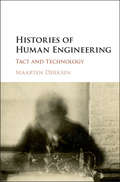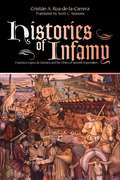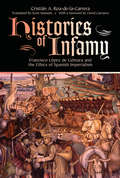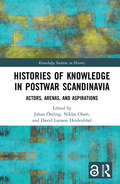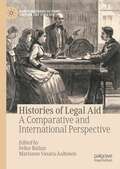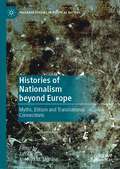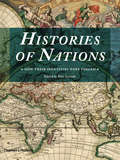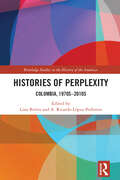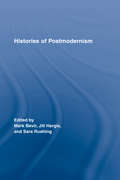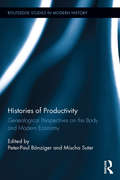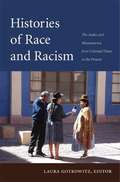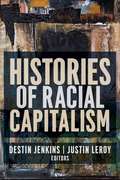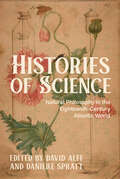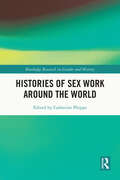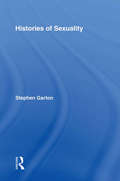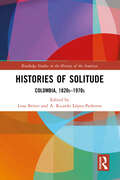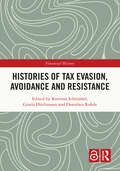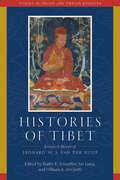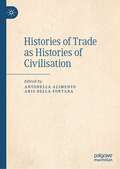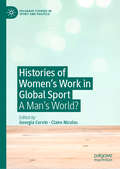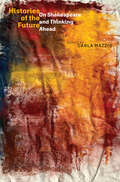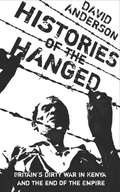- Table View
- List View
Histories of Human Engineering: Tact and Technology
by Maarten DerksenThe dream of control over human behaviour is an old dream, shared by many cultures. This fascinating account of the histories of human engineering describes how technologies of managing individuals and groups were developed from the nineteenth century to the present day, ranging from brainwashing and mind control to Dale Carnegie's art of dealing with people. Derksen reveals that common to all of them is the perpetual tension between the desire to control people's behaviour and the resistance this provokes. Thus to influence other people successfully, technology had to be combined with tact: with a personal touch, with a subtle hint, or with outright deception, manipulations are made palatable or invisible. Combining psychological history and theory with insights from science and technology studies and rhetorical scholarship, Derksen offers a fresh perspective on human engineering that will appeal to those interested in the history of psychology and the history of technology.
Histories of Infamy
by Cristián A. Roa-de-la-Carrera Scott SessionsIn Histories of Infamy, Cristián Roa-de-la-Carrera explores Francisco López de Gómara's (1511-ca.1559) attempt to ethically reconcile Spain's civilizing mission with the conquistadors' abuse and exploitation of Native peoples. The most widely read account of the conquest in its time, Gómara's Historia general de las Indias y Conquista de México rationalized the conquistadors' crimes as unavoidable evils in the task of bringing "civilization" to the New World. Through an elaborate defense of Spanish imperialism, Gómara aimed to convince his readers of the merits of the conquest, regardless of the devastation it had wrought upon Spain's new subjects. Despite his efforts, Gómara's apologist text quickly fell into disrepute and became ammunition for Spain's critics. Evaluating the effectiveness of ideologies of colonization, Roa-de-la-Carrera's analysis will appeal to scholars in colonial studies and readers interested in the history of the Americas.
Histories of Infamy: Francisco López de Gómara and the Ethics of Spanish Imperialism
by Cristián A. Roa-de-la-Carrera"Roa-de-la-Carrera convincingly shows that Gómara, as well as other historians in the period, cannot easily ignore nor erase the contradictions of the Spanish colonial project." - Luis Fernando Restrepo, University of Arkansas “In an eloquent and thorough exegesis, Roa-de-la-Carrera reveals how and why López de Gómara, having written the best of all possible books in exultation of Spanish imperialism, nevertheless failed to convince the readers of his time." - Susan Schroeder, Tulane University In Histories of Infamy, Cristián Roa-de-la-Carrera explores Francisco López de Gómara's (1511-ca.1559) attempt to ethically reconcile Spain's civilizing mission with the conquistadors' abuse and exploitation of Native peoples. The most widely read account of the conquest in its time, Gómara's Historia general de las Indias y Conquista de México rationalized the conquistadors' crimes as unavoidable evils in the task of bringing "civilization" to the New World. Through an elaborate defense of Spanish imperialism, Gómara aimed to convince his readers of the merits of the conquest, regardless of the devastation it had wrought upon Spain's new subjects. Despite his efforts, Gómara's apologist text quickly fell into disrepute and became ammunition for Spain's critics. Evaluating the effectiveness of ideologies of colonization, Roa-de-la-Carrera's analysis will appeal to scholars in colonial studies and readers interested in the history of the Americas.
Histories of Knowledge in Postwar Scandinavia: Actors, Arenas, and Aspirations (Knowledge Societies in History)
by Niklas Olsen Johan Östling David Larsson HeidenbladHistories of Knowledge in Postwar Scandinavia uses case studies to explore how knowledge circulated in the different public arenas that shaped politics, economics and cultural life in and across postwar Scandinavia, particularly in the 1960s and 1970s. This book focuses on a period when the term "knowledge society" was coined and rapidly found traction. In Scandinavia, society’s relationship to rational forms of knowledge became vital to the self-understanding and political ambitions of the era. Taking advantage of contemporary discussions about the circulation, arenas, forms, applications and actors of knowledge, contributors examine various forms of knowledge – economic, environmental, humanistic, religious, political, and sexual – that provide insight into the making and functioning of postwar Scandinavian societies and offer innovative studies that contribute to the development of the history of knowledge at large. The concentration on knowledge rather than the welfare state, the Cold War or the new social and political movements, which to date have attracted the lion’s share of scholarly attention, ensures the book makes a historiographical intervention in postwar Scandinavian historiography. Offering a stimulating point of departure for those interested in the history of knowledge and the circulation of knowledge, this is a vital resource for students and scholars of postwar Scandinavia that provides fresh perspectives and new methodologies for exploration.
Histories of Legal Aid: A Comparative and International Perspective (World Histories of Crime, Culture and Violence)
by Felice Batlan Marianne Vasara-AaltonenThis book focuses on the history of the provision of legal aid and legal assistance to the poor in the nineteenth and twentieth centuries in eight different countries. It is the first such book to bring together historical work on legal aid in a comparative perspective, and allows readers to analogise and contrast historical narratives about free legal aid across countries. Legal aid developed as a result of industrialisation, urbanization, immigration, the rise of philanthropy, and what were viewed as new legal problems. Closely related, was the growing professionalisation of lawyers and the question of what duties lawyers owed society to perform free work. Yet, legal aid providers in many countries included lay women and men, leading at times to tensions with the bar. Furthermore, legal aid often became deeply politicized, creating dramatic conflicts concerning the rights of the poor to have equal access to justice.
Histories of Nationalism beyond Europe: Myths, Elitism and Transnational Connections (Palgrave Studies in Political History)
by Jan Záhořík Antonio M. MoroneThis edited collection explores varying shapes of nationalism in different regional and historical settings in order to analyse the important role that nationalism has played in shaping the contemporary world. Taking a global approach, the collection includes case studies from the Middle East, Africa, Asia and North America. Unique not only in its wide range of geographically diverse case studies, this book is also innovative due to its comparative approach that combines different perspectives on how nations have been understood and how they came into being, highlighting the transnational connections between various countries. The authors examine what is meant by the concepts of ‘nation’ and ‘national identity,’ discussing themes such as citizenship, ethnicity, historical symbols and the role of elites. By exploring these entangled categories of nationalism, the authors argue that throughout history, elites have created ‘artificial ’ versions of nationalism through symbolism and mythology, which has led to nationalism being understood through social constructivist or primordialist lenses. This diverse collection will appeal to researchers studying nationalism, including historians, political scientists and anthropologists.
Histories of Nations: How Their Identities Were Forged
by Peter FurtadoTwenty-eight intimate and unconventional autobiographies of the nation/state, told by historians from their respective countries. Global histories tend to be written from the narrow viewpoint of a single author and a single perspective, with the inevitable bias that it entails. But in this thought-provoking collection, twenty-eight writers and scholars give engaging, often passionate accounts of their own nation's history. The countries have been selected to represent every continent and every type of state: large and small; mature democracies and religious autocracies; states that have existed for thousands of years and those born as recently as the twentieth century. Together they contain two-thirds of the world's population. In the United States, for example, the myth of the nation's "historylessness" remains strong, but in China history is seen to play a crucial role in legitimizing three thousand years of imperial authority. "History wars" over the content of textbooks rage in countries as diverse as Australia, Russia, and Japan. Some countries, such as Iran or Egypt, are blessed--or cursed--with a glorious ancient history that the present cannot equal; others, such as Germany, must find ways of approaching and reconciling the pain of the recent past.
Histories of Perplexity: Colombia, 1970s-2010s (Routledge Studies in the History of the Americas)
by A. Ricardo López-Pedreros Lina BrittoBy combining chronological coverage, analytical breadth, and interdisciplinary approaches, these two volumes—Histories of Solitude and Histories of Perplexity—study the histories of Colombia over the past two centuries as illustrations of the histories of democracy across the Americas.The volumes bring together over 40 scholars based in Colombia, the United States, England, and Canada working in various disciplines to discuss how a country that has been consistently presented as a rarity in Latin America provides critical examples to re-examine major historical problems: republicanism and liberalism; export economies and agrarian modernization; populism and cultural politics of state formation; revolutionary and counterinsurgent Cold War violence; neoliberal reforms and urban development; popular mobilization and counterhegemonic public spheres; political ecologies and environmental struggles; and labors of memory and the challenge of reconciliation. Contributors are sensitive to questions of subjectivity and discourse, observant of ethnographic details and micro-politics, and attuned to macro-perspectives such as transnational and global histories.These volumes offer fresh perspectives on Colombia and will be of great value to those interested in Latin American and Caribbean history.
Histories of Postmodernism (Routledge Studies in Cultural History #5)
by Mark Bevir; Jill Hargis; Sara RushingHistories of Postmodernism reexamines the history of the constellation of ideas and thinkers associated with postmodernism. The increasingly dominant historical narrative depicts a relatively smooth development of ideas from Friedrich Nietzsche and Martin Heidegger, through a range of French theorists, most notably Jacques Derrida and Michel Foucault, to contemporary American thinkers such as Richard Rorty, Edward Said, and Judith Butler. Histories of Postmodernism challenges this narrative by highlighting the local contexts of relevant theorists and thus the crucial distinctions that divide successive articulations of the themes and concepts associated with postmodernism. As postmodern ideas traveled from nineteenth-century Germany to mid-twentieth-century France and on to the contemporary United States, so the relevant theorists transformed that heritage within the context of particular intellectual traditions and specific political and aesthetic issues.
Histories of Productivity: Genealogical Perspectives on the Body and Modern Economy (Routledge Studies in Modern History #21)
by Peter-Paul Banziger Mischa SuterGlobal issues such as climate change and the aftermath of the 2008 financial crisis have spurred interest in thinking about the history of the modern economy that goes beyond disciplinary economic history. This book contributes to the cultural history of capitalism and its different regimes of productivity by pursuing the perspective of body history and by providing a global scope. Throughout modernity, the body served as a fundamental, albeit essentially changing, linchpin for both the organization of economic practices and for intellectual reflections on the economy. In particular, it was the pivotal interface to render notions of economic productivity intelligible. The book explores this central thesis in a range of case studies, drawing on source material from West Africa, Europe, Mexico, and the US. Framed by a theoretically informed introduction, which also provides a conceptual history of notions of productivity, and by an afterword that brings the approaches explored in this volume into dialogue with scholarship inspired by Marx and Foucault, the individual chapters tackle the concept of productivity from a wide array of angles, each illuminating the promises and problems of a cultural take on the history of economic productivity.
Histories of Race and Racism: The Andes and Mesoamerica from Colonial Times to the Present
by Laura GotkowitzNinety percent of the indigenous population in the Americas lives in the Andean and Mesoamerican nations of Bolivia, Ecuador, Mexico, Peru, and Guatemala. Recently indigenous social movements in these countries have intensified debate about racism and drawn attention to the connections between present-day discrimination and centuries of colonialism and violence. In Histories of Race and Racism, anthropologists, historians, and sociologists consider the experiences and representations of Andean and Mesoamerican indigenous peoples from the early colonial era to the present. Many of the essays focus on Bolivia, where the election of the country's first indigenous president, Evo Morales, sparked fierce disputes over political power, ethnic rights, and visions of the nation. The contributors compare the interplay of race and racism with class, gender, nationality, and regionalism in Bolivia, Ecuador, Guatemala, Mexico, and Peru. In the process, they engage issues including labor, education, census taking, cultural appropriation and performance, mestizaje, social mobilization, and antiracist legislation. Their essays shed new light on the present by describing how race and racism have mattered in particular Andean and Mesoamerican societies at specific moments in time.ContributorsRossana BarragánKathryn BurnsAndrés CallaPamela CallaRudi Colloredo-MansfeldMaría Elena GarcíaLaura GotkowitzCharles R. HaleBrooke LarsonClaudio LomnitzJosé Antonio LuceroFlorencia E. MallonKhantuta MuruchiDeborah PooleSeemin QayumArturo Taracena ArriolaSinclair ThomsonEsteban Ticona Alejo
Histories of Racial Capitalism (Columbia Studies in the History of U.S. Capitalism)
by Jenkins, Destin; Leroy, JustinThe relationship between race and capitalism is one of the most enduring and controversial historical debates. The concept of racial capitalism offers a way out of this impasse. Racial capitalism is not simply a permutation, phase, or stage in the larger history of capitalism—since the beginning of the Atlantic slave trade and the colonization of the Americas, capitalism, in both material and ideological senses, has been racial, deriving social and economic value from racial classification and stratification. Although Cedric J. Robinson popularized the term, racial capitalism has remained undertheorized for nearly four decades.Histories of Racial Capitalism brings together for the first time distinguished and rising scholars to consider the utility of the concept across historical settings. These scholars offer dynamic accounts of the relationship between social relations of exploitation and the racial terms through which they were organized, justified, and contested. Deploying an eclectic array of methods, their works range from indigenous mortgage foreclosures to the legacies of Atlantic-world maroons, from imperial expansion in the continental United States and beyond to the racial politics of municipal debt in the New South, from the ethical complexities of Latinx banking to the postcolonial dilemmas of extraction in the Caribbean. Throughout, the contributors consider and challenge how some claims about the history and nature of capitalism are universalized while others remain marginalized. By theorizing and testing the concept of racial capitalism in different historical circumstances, this book shows its analytical and political power for today’s scholars and activists.
Histories of Science: Natural Philosophy in the Eighteenth-Century Atlantic World
by David Alff Danielle SprattSpreading the news of scientific breakthroughs in the eighteenth centuryHistories of Science shows how different forms of media communicated scientific breakthroughs during the long eighteenth century, bringing together eighteen humanities scholars to discuss the representation, reception, and application of natural philosophy in the Atlantic world. In particular, the authors focus on descriptions of scientific discoveries in popular print, with essays on topics as varied as placebo pills, irrigation systems, and navigational technology. And while each contributor advances a discrete argument, the collection coheres in its shared questions of methodology, historicity, and ethics. Histories of Science expands our record of the past, our understanding of the present, and our ability to imagine the future.
Histories of Sex Work Around the World (Routledge Research in Gender and History)
by Catherine PhippsThis book offers snapshots of sex work in global history, examining how it has differed in different places around the world at different points in time. Focusing on certain moments in certain places and examinations of historical lives, it offers a diverse approach with a heavy focus on lived experience to see what selling sex was like instead of what it “meant”. Therefore, this book aims to argue that selling sex has been different at different times and present the diversity of experience in sex work throughout history, through case studies and comparisons.Aimed for students, scholars, and general readers alike, Histories of Sex Work Around the World provides an introduction to the history of sex work within a global perspective. The case studies cover a wide range of topics and geographical regions – from North America to Mexico City to Vietnam, spanning across 12 different countries and over 400 years of history, before considering the future of sex work in the internet age. Furthermore, this book features chapters with personal accounts from writers with experience selling sex, managing a brothel, or working as a dancer. It also includes a foreword from renowned writer and historian Julia Laite, author of bestselling book The Disappearance of Lydia Harvey.
Histories of Sexology: Between Science and Politics (Global Queer Politics)
by Alain Giami Sharman LevinsonHistories of Sexology: Between Science and Politics takes an interdisciplinary and reflexive approach to the historiography of sexology. Drawing on an intellectual history perspective informed by recent developments in science and technology studies and political history of science, this book examines specific social, cultural, intellectual, scientific and political contexts that have given shape to theories of sexuality, but also to practices in medicine, psychology, education and sexology. Furthermore, it explores various ways that theories of sexuality have both informed and been produced by sexologies—as scientific and clinical discourses about sex—in Western countries since the 19th century.
Histories of Sexuality: Antiquity to Sexual Revolution
by Stephen Garton"First Published in 2004, Routledge is an imprint of Taylor & Francis, an informa company."
Histories of Solitude: Colombia, 1820s-1970s (Routledge Studies in the History of the Americas)
by Lina Britto López-Pedreros, A. RicardoBy combining chronological coverage, analytical breadth, and interdisciplinary approaches, these two volumes—Histories of Solitude and Histories of Perplexity—study the histories of Colombia over the last two centuries as illustrations of the histories of democracy across the Americas.The volumes bring together over 40 scholars based in Colombia, the United States, England, and Canada working in various disciplines to discuss how a country that has been consistently presented as a rarity in Latin America provides critical examples to re-examine major historical problems: republicanism and liberalism; export economies and agrarian modernization; populism and cultural politics of state formation; revolutionary and counterinsurgent Cold War violence; neoliberal reforms and urban development; popular mobilization and counterhegemonic public spheres; political ecologies and environmental struggles; and labors of memory and the challenge of reconciliation. Contributors are sensitive to questions of subjectivity and discourse, observant of ethnographic details and micro-politics, and attuned to macro-perspectives such as transnational and global histories.These volumes offer fresh perspectives on Colombia and will be of great value to those interested in Latin American and Caribbean history.
Histories of Suicide
by David Wright John WeaverSuicide is one of the leading causes of death worldwide, with more than one million fatalities each year. During the post-war period, the rate of completed suicides has risen dramatically, especially among young men and Aboriginal peoples living in the Western world. While this has naturally led to growing concern amongst health care practitioners and policy experts, relatively little is known about the history of attempted and completed suicide. Histories of Suicide is the first book to examine the history of suicide in diverse national contexts, including Japan, Scotland, Australia, Soviet Russia, Peru, United States, France, South Africa, and Canada, to reveal the different social, political, economic, and cultural factors that inform our understanding of suicide. This interdisciplinary collection of essays assembles historians, health economists, anthropologists, and sociologists, who examine the history of suicide from a variety of approaches to provide crucial insight into how suicide differs across nations, cultures, and time periods. Focusing on developments from the eighteenth century to the present, the contributors examine vitally important topics such as the medicalization of suicide, representations of mental illness, psychiatric disputes, and the frequency of suicide amongst soldiers. An illuminating volume of studies, Histories of Suicide is a fascinating examination of the phenomenon of self-destruction throughout different historical periods and nations.
Histories of Tax Evasion, Avoidance and Resistance (Financial History #36)
by Dorothea Rohde Gisela HürlimannTax evasion, tax avoidance and tax resistance are widespread phenomena in political, economic, social and fiscal history from antiquity through medieval, early modern and modern times. This book shows how different groups and individuals around the globe have succeeded or failed in not paying their due taxes, whether in kind or in cash, on their properties or on their crops. It analyses how, throughout history, wealthy and poor taxpayers have tried to avoid or reduce their tax burden by negotiating with tax authorities, through practices of legal or illegal tax evasion, by filing lawsuits, seeking armed resistance or by migration, and how state authorities have dealt with such acts of claim making, defiance, open resistance or elusion. It fills an important research gap in tax history, addressing questions of tax morale and fairness, and how social and political inequality was negotiated through taxation. It gives rich insights into the development of citizen-state relationships throughout the course of history. The book comprises case studies from Ancient Athens, Roman Egypt, Medieval Europe, Early Modern Mexico, the Ottoman Empire, Nigeria under British colonial rule, the United Kingdom of the early 20th century, Greece during the Second World War, as well as West Germany, Switzerland, Sweden and the United States in the 20th century, including transnational entanglements in the world of late-modern offshore finance and taxation. The authors are experts in fiscal, economic, financial, legal, social and/or cultural history. The book is intended for students, researchers and scholars of economic and financial history, social and world history and political economy.
Histories of Tibet: Essays in Honor of Leonard W. J. van der Kuijp
by Kurtis R. Schaeffer, Jue Liang, and William A. McGrathThe thirty-four essays in this volume follow the particular interests of Leonard van der Kuijp, whose groundbreaking research in Tibetan intellectual and cultural history imbued his students with an abiding sense of curiosity and discovery.As part of Leonard van der Kuijp&’s research in Tibetan history, as he patiently and expertly revealed treasures of the Tibetan intellectual tradition in fourteenth-century Tsang, or seventeenth-century Lhasa, or eighteenth-century Amdo, he developed an international community of colleagues and students. The thirty-four essays in this volume follow the particular interests of the honoree and express the comprehensive research that his international cohort have engaged in alongside his generous tutelage over the course of forty years. He imbued his students with the abiding sense of curiosity and discovery that can be experienced through every one of his writings, and that can be found as well in these new essays in intellectual, cultural, and institutional history by Christopher Beckwith, the late Hubert Decleer, Franz-Karl Ehrhard, Jörg Heimbel and David Jackson, Isabelle Henrion-Dourcy, Nathan Hill, Matthew Kapstein, Kurtis Schaeffer, Michael Witzel, Allison Aitken, Yael Bentor, Pieter Verhagen, Todd Lewis, William McGrath, Peter Schwieger, Gray Tuttle, and others.
Histories of Trade as Histories of Civilisation
by Antonella Alimento Aris Della FontanaThis edited collection explores the histories of trade, a peculiar literary genre that emerged in the context of the historiographical and cultural changes promoted by the histoire philosophique movement. It marked a discontinuity with erudition and antiquarianism, and interacted critically with universal history. By comparing and linking the histories of individual peoples within a common historical process, this genre enriched the reflection on civilisation that emerged during the long eighteenth century. Those who looked to the past wanted to understand the political constitutions and manners most appropriate to commerce, and grasp the recurring mechanisms underlying economic development. In this sense, histories of trade constituted a declination of eighteenth-century political economy, and thus became an invaluable analytical and practical tool for a galaxy of academic scholars, journalists, lawyers, administrators, diplomats and government ministers whose ambition was to reform the political, social and economic structure of their nations. Moreover, thanks to these investigations, a lucid awareness of historical temporality and, more particularly, the irrepressible precariousness of economic hegemonies, developed. However, as a field of tension in which multiple and even divergent intellectual sensibilities met, this literary genre also found space for critical assessments that focused on the ambivalence and dangers of commercial civilisation. Examining the complex relationship between the production of wealth and civilisation, this book provides unique insights for scholars of political economy, intellectual history and economic history.
Histories of Women's Work in Global Sport: A Man’s World? (Palgrave Studies in Sport and Politics)
by Georgia Cervin Claire NicolasSport has never been a man’s world. As this volume shows, women have served key roles not only as athletes and spectators, but as administrators, workers, decision-makers, and leaders in sporting organizations around the world. Contributors excavate scarce archival material to uncover histories of women’s work in sport, from swimming teachers in nineteenth-century England to national sports administrators in twentieth-century Côte d’Ivoire, and many places in between. Their work has been varied, holding roles as teachers, wives, and secretaries in sporting contexts around the world, often with diplomatic functions—including at the 1968 and 1992 Olympic Games. Finally, this collection shows how gender initiatives have developed in sporting institutions in Europe and international sport federations today. With a foreword by Grégory Quin and afterword by Anaïs Bohuon, this is a pioneering study into gender and women’s work in global sport.
Histories of the Future: On Shakespeare and Thinking Ahead
by Carla MazzioWhat early modern and Shakespeare studies have to offer contemporary thinking about the futureWhat do early modern and Shakespeare studies have to offer contemporary thinking about the future? Joining a series of urgent conversations about “the future” as an object of analysis and theorization in early modern history, art history, literature, science, theology, and law, Histories of the Future addresses this question directly. This volume brings together essays that draw on early modern modes of “thinking ahead” to reconsider the ways in which the teaching and reading of Shakespeare help shape how one imagines the future from the vantage point of today.By stressing the importance of understanding how future-oriented thinking in the past informs perceptions of possibility in the present—with special attention to contemporary issues of climate change, economic inequality, race and indigeneity, queer lives, physical and mental health crises, academic precarity, conditions of scholarly labor, and the ongoing disastrous effects of settler colonialism—Histories of the Future contributes to a rich and expanding field of scholarship on temporality in pre- and early modern literatures and cultures. In the process, it also engages with key insights of twenty-first-century critical and cultural theory in reexamining historical issues ranging from the imagined inevitability of progress or apocalypse to fraught conditions of succession, chronology, catastrophe, influence, prophecy, and risk.With essays by J. K. Barret, Urvashi Chakravarty, Drew Daniel, John Garrison, Margreta de Grazia, Jean E. Howard, Jeffrey Masten, Marissa Nicosia, Vimala Pasupathi, Kathryn Vomero Santos, and Scott Manning Stevens, Histories of the Future explores the possibilities and limits of early modern futures for “thinking ahead” today.
Histories of the Hanged: Britain's Dirty War in Kenya and the End of Empire
by David AndersonThe true story of the Mau Mau rebellion of 1952-60 in Kenya, told for the first timeThis book tells for the first time the story of the dirty war the British fought in Kenya, in the run-up to the country's independence in 1964. In 1952, after years of tension and bitterness, the grievances of the Gikuyu people of central Kenya exploded into open rebellion. Only 32 European settlers died in the subsequent fighting, but more than 1,800 African civilians, over 3,000 African police and soldiers, and 12,000 Mau Mau rebels were killed. Between 1953 and 1956 Britain sent over a thousand Kenyans to the gallows, often on trumped up or non-existent charges. Meanwhile 70,000 people were imprisoned in camps without trial for between two and six years. David Anderson provides a full and convincing account of a war in which all sides behaved badly, and therefore few of the combatants can be either fully excused, or blamed. These events are still within living memory, and eye-witness testimonies provide the backbone of this controversial story.
Histories of the Hanged: Britain's Dirty War in Kenya and the End of Empire
by David AndersonThe true story of the Mau Mau rebellion of 1952-60 in Kenya, told for the first timeThis book tells for the first time the story of the dirty war the British fought in Kenya, in the run-up to the country's independence in 1964. In 1952, after years of tension and bitterness, the grievances of the Gikuyu people of central Kenya exploded into open rebellion. Only 32 European settlers died in the subsequent fighting, but more than 1,800 African civilians, over 3,000 African police and soldiers, and 12,000 Mau Mau rebels were killed. Between 1953 and 1956 Britain sent over a thousand Kenyans to the gallows, often on trumped up or non-existent charges. Meanwhile 70,000 people were imprisoned in camps without trial for between two and six years. David Anderson provides a full and convincing account of a war in which all sides behaved badly, and therefore few of the combatants can be either fully excused, or blamed. These events are still within living memory, and eye-witness testimonies provide the backbone of this controversial story.
